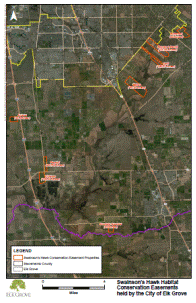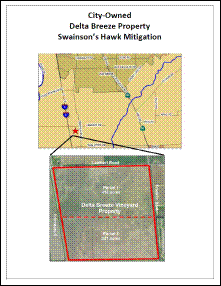Swainson's Hawk Program
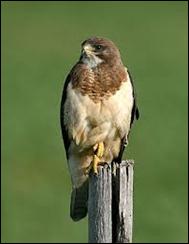
The Swainson's hawk (Buteo swainsoni) is a state-listed threatened species in California that was listed in 1983 by the California Fish and Game Commission due to its diminishing habitat and the decreased population numbers across the state. Today, the majority of the population in California resides throughout much of the California Central Valley that extends from Tehama County to Tulare and Kings Counties. However, the population core is located within portions of Yolo, Solano, Sacramento, and San Joaquin Counties, which provides the most optimum foraging habitat and nesting conditions for the hawks. The City of Elk Grove (City) lies within the core area that provides suitable Swainson's hawk habitat consisting of large, open grassland and agricultural landscapes. Historically, Swainson's hawks foraged in the agricultural lands in and around Elk Grove.
Swainson's Hawk Distribution in the California Central Valley
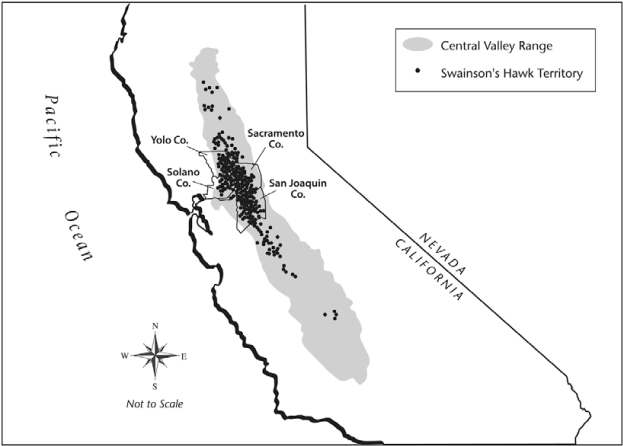
Map Source: The Distribution, Abundance, and Habitat Associations of the Swainson's Hawk in the City of Elk Grove, January 2009.
Swainson's Hawk Characteristics
The Swainson's hawk is characterized by its long, narrow, and tapered wings held in flight in a slight dihedral shape while the bird is in flight. The most distinctive identifying feature of adults is the dark head and breast band that is distinctive from the lighter colored belly, and the underside of the wing with the linings lighter than the dark gray flight feathers. Adult females weigh between 900 and 1100 grams (32 to 39 oz), and males from 800 to 1000 grams (28 to 35 oz).
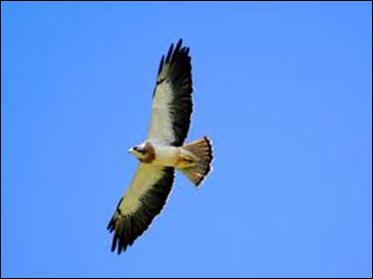
Swainson's Hawk in Flight
Swainson's hawks are migratory birds of prey that spend their breeding season (roughly March 15th thru September 15th) in the Central Valley and their winters on the plains of southern Brazil and Argentina. Their migratory route can be as long as 14,000 miles; lasting at least two months to make the long distance flight. Certain types of agricultural crops and pastures provide excellent foraging habitat for Swainson's Hawks, especially crops that support large insects, such as grasshoppers, or small mammals such as meadow voles and mice. Crops or grazing regimes that expose prey to aerial predation is the preferred foraging habitat. Typical Swainson's Hawks' agricultural foraging areas include alfalfa, irrigated pasture, dryland pasture, and some low-growing row crops such as tomatoes, beans, beets, etc. Grain fields such as wheat and oats are also known to serve as important cover types for foraging Swainson's Hawks after they are harvested. Crops such as corn, rice, sunflower, safflower, orchards, or vineyards are not considered suitable as foraging habitat. Swainson's hawks typically hunt in flight or from perches located near foraging areas. Sight is the primary means of detecting prey so low-growing vegetation or sparsely vegetated areas typically exposes prey to the hawks more easily than dense or tall growing vegetation. Typical flood irrigation can also benefit the hawks by forcing small mammals and insects to retreat from their hiding places.
Typical Central Valley Swainson's Hawk Foraging Habitat
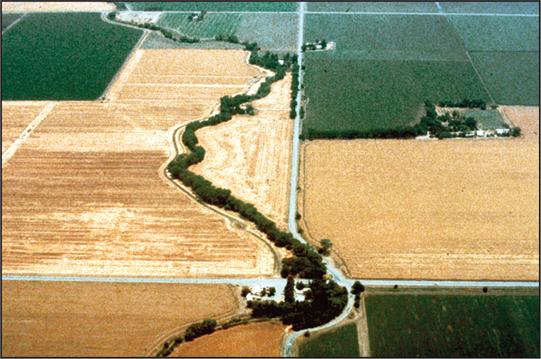
Elk Grove Swainson's Hawk Mitigation
As agricultural lands converted to urban development in Elk Grove, the hawk's foraging habitat was equally being displaced. Following the vision of the citizens in Elk Grove, one of the City's General Plan guiding goals is the protection of the natural environment. To implement this goal, the General Plan contains policies aimed at protecting the City's natural resources, which would include the loss of Swainson's hawk foraging habitat.
In 2003, the City established and adopted Chapter 16.130 (Swainson's Hawk Impact Mitigation Fees) of the Elk Grove Municipal Code, which establishes mitigation policies tailored for projects in Elk Grove that have been determined through the California Environmental Quality Act (CEQA) process to result in a "potential significant impact" on Swainson's hawk foraging habitat. Chapter 16.130, often referred as the "Swainson's Hawk Code," serves as a conservation strategy that is achieved through the selection of appropriate replacement lands and through management of suitable habitat value on those lands in perpetuity. To mitigate for the loss of foraging habitat in the City, the Swainson's Hawk Code allows a project applicant to provide mitigation by one or a combination of the following options:
- Provide direct land preservation to the Cityby fee title or conservation easement on a per acre basis (one-to one mitigation ratio), including an endowment for easement monitoring. Interests in mitigation lands are to be held in trust by an entity acceptable to the City and/or the City in perpetuity.
- Pay Swainson's Hawk impact mitigation feeon a per acre basis of habitat impacted. The current fee is listed in the Development Related Fee Booklet, which the City utilizes the fees collected to mitigate the project's impacts by acquiring land in fee title and/or conservation easements on suitable Swainson's hawk foraging habitat.; Swainson's Hawk payment of a mitigation fee is limited to projects less than 40 acres.
- Purchase mitigation creditsat an accredited mitigation bank that is acceptable to the City and California Department of Fish and Game.
- Purchase credits from a property ownerwith eligible credits for projects in Elk Grove that is acceptable to the City and California Department of Fish and Game.
- Provide other instrumentsto preserve suitable habitat as determined by the California Department of Fish and Game.
Conservation Easement Lands and Delta Breeze Property
The City has received and currently holds a total of seven conservation easements as a form of Swainson's hawk mitigation for projects occurring in Elk Grove. As mentioned, direct land preservation by conservation easement is allowed as a mitigation option with the establishment of an associated endowment to cover the cost of monitoring. The conservation easements that the City has accepted are dispersed throughout southern Sacramento County in areas that would ensure the maximum benefit to the Swainson's hawk by maintaining habitat connectivity with adjacent open foraging habitat lands, which together provides regional hawk population stability - see map below for easement locations. The conservation easements are in perpetuity and the City conducts annual monitoring for all easements to ensure that the conservation easement restrictions are enforced -; the link to the conservation easement annual reports are available in the table below.
In addition to the conservation easements, the City purchased two parcels totaling 743 acres in 2005 at the southwest corner of Franklin Boulevard and Lambert Road. The purpose of the purchase was to satisfy the City's obligation of acquiring suitable Swainson's hawk foraging habitat lands for projects mitigating by paying the Swainson's hawk mitigation fee. The mitigation property, known as the "Delta Breeze Property," is currently managed by the U.S. Bureau of Land Management (BLM) in association with the Cosumnes River Preserve. The BLM currently manages several agricultural leases as part of their on-going operations at the Preserve. The BLM will manage the Delta Breeze Property consistent with the terms and conditions of the Conservation Easement and the Preserve's March 2008 Final Management Plan (found atwww.cosumnes.org).
In 2009, a conservation easement was placed on 736 acres of the 743-acre Delta Breeze Property and transferred along with an endowment to the Nature Conservancy. This easement ensures that the Property will be managed as agricultural land and for the benefit of the Swainson's hawk in perpetuity. Currently, the property is leased to a local farmer and farmed in a manner that is consistent with the conservation easement.
The table below lists the City-held conservation easements, which additional information for each easement may be obtained by clicking on the "Fact Sheet" label for the respective easement property. In addition, the annual easement monitoring reports for each City-held conservation easement are available for viewing by clicking on the reporting year (except Delta Breeze Property). As the conservation easement for the Delta Breeze Property is held by The Nature Conservancy, the annual reporting of the Delta Breeze Property will be included as part of the reporting program established for the Cosumnes River Preserve. However, the grant deed establishing the conservation easement on the Delta Breeze Property may be viewed by clicking on the "Grant Deed for Conservation Easement" under the Delta Breeze easement heading in the table below.
Swainson's Hawk Habitat Conservation Easements
| Easement Property | Easement Acreage(1) | Location | Fact Sheet | Easement Monitoring Report |
|---|---|---|---|---|
| Acterra | 91.8 | South end of Stone Lake Rd. and east of I-5 | Fact Sheet | |
| Carli | 150.21 | 1-mile SW of Grant Line Rd. | Fact Sheet | |
| Delta Breeze | 736.6 | SW corner of Franklin Blvd. & Lambert Rd. | Grant Deed for Conservation Easement | |
| Goodwin-Gwerder | 80 | South of Kost Rd. and .5 mile east of Orr Rd. | Fact Sheet | |
| Kirkham | 169 | SW corner of Twin Cities Rd. & Franklin Blvd. | Fact Sheet | |
| Mahon | 62.35 | South of the Grant Line Rd. & Waterman Rd. intersection | Fact Sheet | |
| Mohamed | 80 | Southeast of the Grant Line Rd. & Wilton Rd. intersection | Fact Sheet | |
| Pennisi | 90.8 | NW corner of Franklin Blvd. & Twin Cities Rd. | N/A | N/A |
| Reynen & Bardis | 14.75 | East of the Grant Line Rd. & Freeman Rd. intersection | Fact Sheet |
(1) Easement acreage may just be a portion of the total parcel size.
Swainson's Hawk Studies
In order to obtain better information regarding hawk nesting and foraging sites, the City funded a baseline survey in 2006 to provide the City with a more complete understanding of the distribution and population of Swainson's hawks in south Sacramento County. A subsequent report on the Swainson's hawk population in south Sacramento County was released in 2009 that provided results from the continuation of on-going data collection and field work to evaluate the City's Swainson's hawk mitigation strategy. In order to provide additional information on Swainson's hawk nesting distribution and abundance within the Elk Grove city limit, a survey was conducted in 2008 with the final report released in 2009. All three reports are available for review below by clicking on the selected report.
- The Distribution, Abundance, and Habitat Associations of Swainson's Hawk (Buteo swainsoni) in South Sacramento CountyApril 2007
- Monitoring Swainson's Hawk (Buteo swainsoni) Nesting Activity in South Sacramento County Results of 2008 SurveysFebruary 2009
- The Distribution, Abundance, and Habitat Associations of the Swainson's Hawk (Buteo swainsoni) in the City of Elk GroveJanuary 2009
Contact Information
| Housing | |
|---|---|
Planner ManagerAntonio Ablo |
(916) 627-3335
8401 Laguna Palms Way |


